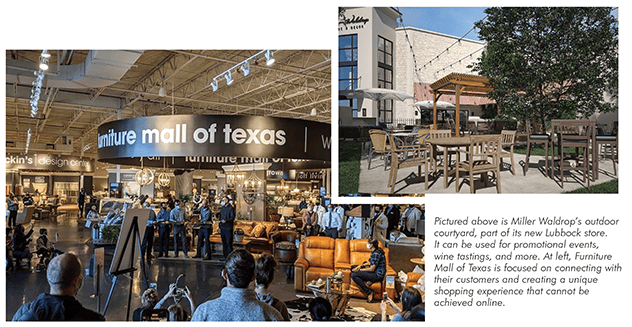
A fundamental shift has occurred in the way forward thinking home furnishings retailers are approaching store design.
As we look forward to resuming our lives post-COVID, the furniture shopping experience has already shifted and furniture store design along with it.
Both online and offline experiences should be seamless, working together to reinforce each other.
|
Our retail design firm, Retail in the City, is based New York City. On the first warm day after a hard winter, the bustle and renewed energy on the streets was palpable. It felt like pre-COVID times, except for the obvious fact that people were wearing masks. At that moment, it seemed like most folks were done with the pandemic—ready to enjoy all the city had to offer, virus-be-damned. So, as conditions improve further, will life simply return to a new normal or has a fundamental shift already occurred in the way people shop? What does that mean for furniture store owners as they adapt their stores’ experiences to the way people will want to shop for home furnishings?
This article includes insights to help answer that question using examples from some of our retail furniture store clients including Mathis Brothers, Miller Waldrop, Furniture Mall of Texas and Boulevard Home.
Online Shopping
In the post-COVID shopping world, retailers must continually improve their online experience to better reflect what is going on in their physical store environments (and vice versa). Both online and offline experiences should be seamless, working together to reinforce each other. For example, the furniture that shoppers see online should also be showcased on your store floor if you want them to find items easily.
3D Virtual Tours at Mathis Brothers: Mathis Brothers has introduced 3D virtual tours on its website for each of its major stores, some as large as 180,000 square feet. They’ve hired Matterport to scan each with a 3D camera and use a sophisticated AI platform to turn scans into interactive 3D models. The stores are rescanned every three months to make sure that products on display are also the latest offered online. Customers can immersively walk through each store without ever leaving their homes. They can also take rough measurements of furniture items. Then, if they come into the physical store, they will know exactly how to navigate to an item.
Furniture retailers should expect that their customers will continue to shop online before ever walking into their stores. They will bring with them a short list of items being considered and will be ready and motivated to buy. It is a retailer’s job to use tools at hand to provide an exceptional guest service experience. One of these tools is innovative store design to make the purchase experience as easy and as seamless as possible.
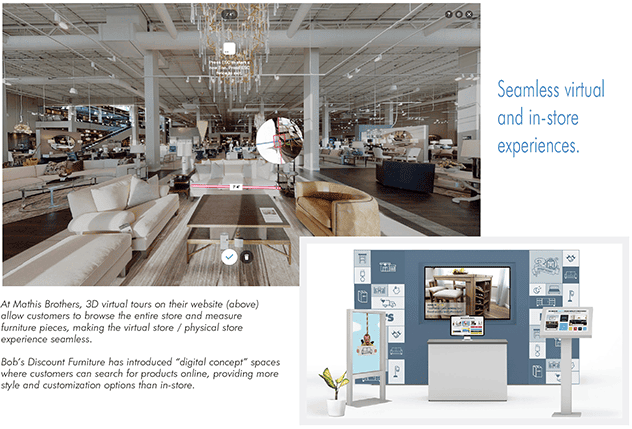
Rethink In-Store Shopping
Allow for increased side-by-side selling: Imagine replacing your long customer service counter with a series of small sit-down areas equipped with digital devices. This would facilitate one-on-one, side-by-side meetings at the start of the sales process. Also, instead of having private sales rooms or an impersonal checkout area, have customers fill out their credit information or pay on an iPad while sitting comfortably anywhere in the store.
The benefits of moving to a virtual sales system: iPads can also be used by salespeople to answer questions that come up or provide other information as needed by scanning any item on the sales floor. Using mobile devices can also help you to reclaim retail display space from square footage typically allocated to offices and checkout counters. Fundamentally, this will shift the way you sell furniture and how you treat customers the moment they walk through the door.
Think about adding a pre-shopping presentation area: A pre-shopping area at the front of your store can help pre-shoppers quickly find where the furniture they liked online is located physically in your store.
Bob’s Discount Furniture is running with this idea. They’ve installed new digital concept spaces upfront in their stores. At a simple level, the digital concept spaces are just a series of interactive screens and digital devices that allow customers to search for products. But they do more than that: they strategically communicate to customers that Bob’s is offering a seamless shopping experience—whether the customer shops in-store or online. And, it reminds them that if they don’t find what they are looking for in-store, there are even more styles and customization options available online. So, it’s practically impossible to not find what they want. That’s a strong message.
Consider smaller footprints for some stores: Ultimately, if you provide completely seamless online and offline experiences—with products presented online in a captivating way using strong visualizations and customization options—you can profit by reducing the footprints of some of your stores. Your large, destination mega-stores can still feature everything you have to offer. But smaller stores can be added as satellite locations, perhaps in markets you have not considered previously. These satellite stores will be able to more effectively rely on interactive online experiences to show additional customization or style options.
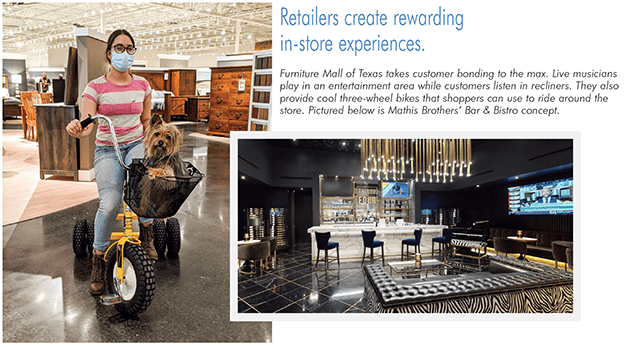
Personalization Within the Store Environment
To get customers to visit physical stores, retailers need to offer an experience that is wholly unique and can’t be achieved online. Deprived of human interaction for a prolonged period during the pandemic, customers instinctively want someone to give them the personalized shopping experience they’ve missed.
If you don’t have one, you should consider adding a beverage station or counter where guests can be offered water, coffee, even some snacks. This helps to bring a sense of fun back into the shopping experience.
Furniture Mall of Texas creates a unique shopping experience: The new Furniture Mall of Texas store, for example, makes it easy for customers to bond with the brand and enjoy the experience of furnishing their homes. They offer small three-wheel bikes that customers use to ride around while shopping. The store has a live entertainment area where musicians perform while customers relax and try out recliners. There is also a 2,000-square-foot indoor/outdoor Howdy Cafe serving coffee, beverages, food and more. Expectations are that the cafe will draw more than just furniture shoppers. It will also serve as a co-working space for those in the neighborhood who want a change of venue from their home office setup.
Mathis Brothers adds a high-end Design Center experience: Mathis Brothers emphasizes customer amenities within their high-end Design Center. Featured is a luxury Bar & Bistro where customers can take a break, order a glass of wine and have a bite to eat. And, customers can take that wine with them as they walk around the store with their pre-booked decorator/Style Advisor. Mathis encourages customers to select and book appointments with decorators in advance so the interaction is as personalized as possible. It makes the experience of shopping for furniture more like spending the day at a spa or one’s favorite salon.
Part of that experience includes sitting down with a pre-selected Style Advisor in their Design Center, which features large communal tables and back-to-back digital screens. Personalized presentations are made using fabric samples that are beautifully hung around the inside perimeter of the space. The Design Center serves as a hub for customization ideas and will become even more significant as the ability to customize products online gets fully integrated into the store environment.
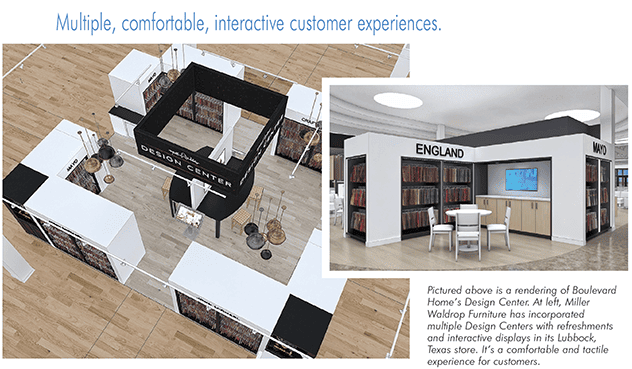
Boulevard Home’s new Design Center: Boulevard Home has also embraced this approach at their new Mesquite, Nevada, store. Even though their store is only 25,000 square feet, it has a generous Design Center at the back of the guest services area located in the center of the store. The Design Center can display up to 150 linear feet of fabrics, has a separate materials sample room, features two sit-down tables where customers and decorators can converse, and displays large digital screens for looking up products and showing customization options.
Miller Waldrop Furniture’s new Design Center: Miller Waldrop Furniture is doing something similar at their new Lubbock, Texas, location. Since the store has two floors, they incorporated multiple Design Center areas. The one upstairs is close to 1,000 square feet, featuring 200 linear feet of fabrics along with samples from Daniel’s Amish, Canadel, and others. Large-scale leather hides will hang from hooks so customers can get a full sense of the leather quality and finish. A built-in refrigerator will allow designers to quickly offer customers a cool beverage. Since furniture products can now be so easily customized using 3D visualizations, the impact of Miller Waldrop’s Design Center on sales will increase as shoppers create furniture pieces unique to them and their sense of style.
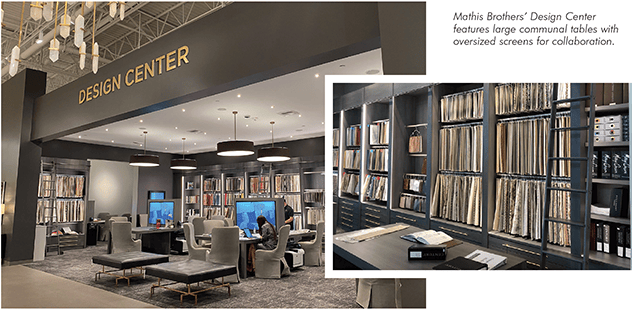
Include Outdoor Spaces
As a society, we collectively learned that enclosed interior spaces present more of a risk of spreading the COVID virus than outdoor space. Therefore, some retailers are seeing a benefit in offering outdoor areas as an alternative to shopping in-store. Retailers are using these spaces for hosting and promoting events that still serve to drive customers to stores but without the risk associated with hosting an event within a tight, enclosed space.
Miller Waldrop’s courtyard: Miller Waldrop renovated an outdoor courtyard as part of its new Lubbock store so it can be used for a grand opening party, plus other promotional events, wine tastings, and more. It will feature patio dining and living sets and have an outdoor kitchen along with a covered patio area to offer protection from inclement weather. The courtyard will be fully landscaped with trees, grass, plants, outdoor lighting and more. It even has a separate entrance from the parking lot to accommodate customers who want to meet with a salesperson outside to do their shopping.
Add Privacy & Personal Space
While some customers may have no concerns about resuming face-to-face interactions right away, for others it will be a slow adjustment. Some may choose to forego face-to-face interaction altogether. Stores that provide varying ways to interact with customers will do well.
Multiple pathways: For customers who want to navigate your store on their own, wayfinding should be simple. Circulation routes should take customers around the entire store, and be fluid and easy to follow. Multiple pathways allow people to space themselves out to avoid other shoppers. Open plans with high ceilings make stores feel expansive, helping customers feel that they are not going to get trapped in a back corner or an enclosed space with others. Stores with open ceilings give the impression that air has plenty of space to circulate.
Mathis Brothers...
is planning for a 4-lane covered pick-up area
at the front of their store to show customers how easy their pick-up
process is
|
Browse without assist: Shoppers should be able to easily learn about the furniture displayed in your store without the need for salesperson assistance. Interactive kiosks, digital screens and product tags with easy-to-scan QR codes allow them to navigate on their own.
Saatva’s brick & mortar solution: Saatva, the online, high-end mattress brand, includes digital stands next to each mattress at their New York City showroom location. Customers can quickly scroll through and understand the difference between each mattress on the floor. The digital interface mimics the shopping experience on Saatva’s website, where each mattress’s special features are summarized in an easy-to-digest way. The company wants customers to roam the store on their own and have all the information they need to make an informed purchasing decision. Their showroom has less product on display than in a typical mattress store. Each model has privacy from the next, so that personal space is always observed. Going forward, stores will be well advised to stop jamming as much merchandise as possible into a space so that customers can shop more comfortably-distanced from one another.
Comfortable pick-up & delivery areas: For some customers, this means never having to set foot in an actual store. The option to order furniture online and have it easily delivered or picked-up is an important benefit for many customers. Furniture retailers are discovering that having clear, designated pick-up areas helps minimize in-person contact. Working parents, who may have kids in tow, appreciate not having to leave their cars while their goods are loaded. Mathis Brothers’ Ontario, California, distribution center and retail store will include a re-imagined four-lane covered pick-up area at the front of their store. Instead of being hidden away in the back it will show customers how easy their pick-up process is.
Cleanliness
The importance of maintaining a clean and sanitized store environment is more important than ever before. When people walk into your store they should get an immediate perception that cleanliness is important to you. If a store feels clean and safe, they will feel comfortable lingering and touching the furniture and textures. This will increase the likelihood of a purchase.
Mattress testing: Mattress departments need to create a number of positive touchpoints. Best practices include providing every guest with their own pillowcase to put on the sample pillow they will use to mattress test. Laying down fresh paper sheets on each test bed is appreciated as well. This kind of attention to detail, plus providing customers with multiple sanitation options, will go a long way toward creating a positive perception of your brand.
Store air quality: For interior spaces, air quality and air filtration systems will be an ongoing concern. Since airplanes and trains, along with some offices and restaurants, have upgraded air systems to reassure visitors, this same expectation may extend to furniture and bedding operations. Local municipalities may increase their standards, requiring a certain amount of airflow and filtration by building code for different types of businesses. For this reason, you may need to upgrade your heating and cooling systems. However, cheaper and easier methods for filtering air may soon be available.
The CLean AIR UVGI Light System, for example, manufactured by Code Lumen, is a simple ultraviolet light that can be easily installed to inactivate 99 percent of viruses and bacteria, including COVID-19. Supplied by Visual Graphic Systems, Inc., the fixture retails for around $1,000. VGS, Inc., also provides a UVGI (Germicidal UV Imager) mapping of your physical space to determine how many units you need and where they should be placed. For many stores, one fan every 1,000 square feet is enough.
“During COVID, protection has become more important. People who are redoing their homes are emphasizing automated appliances, installing air filter systems and purifying fabrications to protect home environments. IKEA recently started selling a line of purifying curtains by GUNRID made from recycled PET bottles. When activated by daylight they reduce home pollutants. We will see more cooling and purifying finishes, especially in the bedding category. Also, look for more recycled materials, vegan leathers, stoneware and unusual, renewable natural materials.”
Conclusion
The furniture shopping experience
has shifted. To be competitive in this fast evolving retail landscape
it’s important to consider how your physical stores need to adapt.
|
Before the pandemic, many furniture retailers were already taking steps to provide better in-store customer service, cleaner store environments, multiple pick-up and delivery options, improved websites, additional store amenities and seamless online/in-store buying experiences. COVID has pushed them to embrace these concepts more quickly. Just about everyone is thinking about new and creative ways to engage with customers. Let’s face it: retailers need to make sure that their customers have exciting and worthwhile reasons to visit and they need to feel comfortable in stores. To be competitive in this fast evolving retail landscape it’s important to consider how your physical stores need to adapt.
